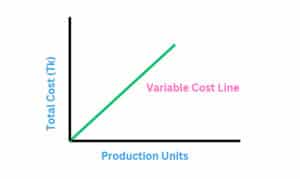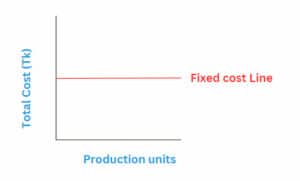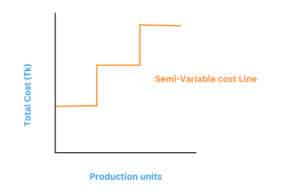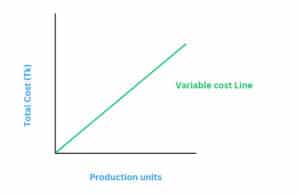8. Flexible Budget
🔷 Question-01. Flexible Budgets
Flexible budgets:
Flexible budgets are budget plans that adjust according to changes in activity levels or sales volumes. It can change or flex when production, sales or some other activity increases or decreases. A flexible budget is also referred to as a variable budget.
Example: A company decides to spend Tk. 10 for every unit sold on marketing.
Flexible Budgets like as:
| Name of cost | Present sales 5,000 units | Increase sales 8,000 units | Decrease sales 4,000 units |
|---|---|---|---|
| Marketing expenses per unit Tk.10 | Tk.50,000 | Tk.80,000 | Tk.40,000 |
At last we say that, fixed budget is same on all activity level but flexible budget is variable.
🔶 Question-02. Fixed Budgets
Fixed budge:
A fixed budget sets spending amounts that don’t change, no matter what happens. A fixed budget is a budget that does not change or flex when production, sales or some other activity increases or decreases. A fixed budget is also referred to as a static budget.
Example: A company plans to spend Tk. 50,000 on marketing every month, regardless of whether sales go up or down. Fixed Budgets like as:
| Name of cost | Present sales | Increase sales | Decrease sales |
|---|---|---|---|
| Marketing expenses | Tk.50,000 | Tk.50,000 | Tk.50,000 |
At last we say that, fixed budget is same on all activity level but flexible budget is variable.
🔶 Question-03. Advantages of flexible Budgets
Basically, flexible budgets provided more advantage to business and non-business organization. Some important discuss here,
1. Decision-Making:
business can make better and perfect decision with actual revenue and cost prediction using flexible budgets.
2. Cost Control:
Perfect cost estimation can be possible using flexible budgets and it can help to reduce cost of the organization.
3. Risk Management:
It can help to reduce risk by providing a clean picture of future revenue at different activity level.
4. Improve Plan:
flexible budget helps to make proper production or sales plan which level of activity gives higher profit.
5. Performance Evaluation:
It can help to evaluate at which level of activity gives better performance or gives higher profit by using lower cost.
At last we say that, flexible budgets help to make more effective and realistic decision.
🔶 Question-04. Analysis of Cost behavior
The way a specific cost reacts to changes in activity levels is called cost behavior. Costs may stay the same or may change proportionately in response to a change in activity. Costs can be classified by three types like as (a) variable (b) fixed and (c) semi-variable.
(a) Fixed cost (স্থায়ী ব্যয়):
Fixed costs are those that stay the same in total regardless of the number of units produced or sold. Although total fixed costs are the same, fixed cost per unit changes as fewer or more units are produced.
Example: A company plans to spend Tk. 50,000 on marketing every month, regardless of whether sales go up or down. Fixed Budgets like as:
| Name of cost | Present sales 5,000 units | Increase sales 8,000 units | Decrease sales 4,000 units |
|---|---|---|---|
| Marketing expenses (total cost) | Tk.50,000 | Tk.50,000 | Tk.50,000 |
| Marketing expenses (per unit) | Tk.10 | Tk.6.25 | Tk.12.5 |
(b) Variable cost (পরিবর্তনশীল ব্যয়):
Variable costs are the costs that change in total each time an additional units produced or sold. With a variable cost, the per unit cost stays the same, but the more unit produced or sold higher the total cost.
Example: A company decides to spend Tk. 10 for every unit sold on marketing.
Flexible Budgets like as:
| Name of cost | Present sales 5,000 units | Increase sales 8,000 units | Decrease sales 4,000 units |
|---|---|---|---|
| Marketing expenses (total cost) | Tk.50,000 | Tk.80,000 | Tk.40,000 |
| Per unit cost | Tk.10 | Tk.10 | Tk.10 |
(c) Semi-variable cost (আধা পরিবর্তনশীল ব্যয়):
Semi-variable costs are costs that contain both a variable element and fixed element. In other side, semi-variable costs are those which are partly fixed and partly variable. Semi-variable costs change in total but not proportionately.
Example: A company decides to spend Tk. 10 for every unit and fixed Tk.50,000 on marketing.
Semi-variable cost Budgets like as:
| Name of cost | Present sales 5,000 units | Increase sales 8,000 units | Decrease sales 4,000 units |
|---|---|---|---|
| Marketing expenses: per unit Tk.10 fixed Tk.50,000 | Tk.1,00,000 | Tk.1,30,000 | Tk.90,000 |
Semi-variable cost shown in graph.
At last we say that, follows a ratio of variable cost, constant of fixed cost and half variable cost
By analyzing cost behavior, businesses can make proper decision of pricing, production levels and profitably.
🔶 Question-05. The difference between Fixed budget and flexible Budget.
Discuss the difference between fixed and variable budgets are as follows:
| Key difference | Fixed Budget ( স্থায়ী বাজেট) | Flexible Budget ( নমনীয় বাজেট) |
|---|---|---|
| Meaning | The budget designed to remain constant, regardless of the activity level reached is fixed budget. | The budget designed to change with the change in the activity level is flexible budget. |
| Nature | Static | Dynamic |
| Activity level | Only one | Multiple |
| Estimates | Base on assumption | Realistic and practical |
| Examples | Depreciation ,rent, salary, insurance, tax etc. | Material, labor, commission on sale, packing exp etc. |
| Per unit | Per unit cost variable | Per unit cost fixed |
🔶 Question-06. The difference between Relevant cost and irrelevant cost.
Relevant costs directly impact decision-making, while irrelevant costs have no impact on the alternatives consideration.
| Key difference | Relevant cost | Irrelevant Cost |
|---|---|---|
| Meaning | Costs that directly impact a decision. | Costs that do not impact a decision. |
| Nature | Related to the decision and capable of affecting the outcome. | Not related to the decision and incapable of affecting the outcome. |
| Activity level | Vary with changes in activity levels or alternative choices. | Remain same at all activity level. |
| Estimates | Estimate by the particular situation of the decision. | Estimate for both situation of the decision. |
| Examples | Purchase price of raw materials, additional labor costs, incremental revenue from a new product line. | Sunk costs, past advertising expenses, depreciation of existing equipment. |
NU Question With Easy Solution
উত্তর দেখতে প্রশ্নের উপর ক্লিক করুন।
Fixed Budgets:
A fixed budget sets spending amounts that don't change, no matter what happens. A fixed budget is a budget that does not change or flex when production, sales or some other activity increases or decreases. A fixed budget is also referred to as a static budget.
Example: A company plans to spend Tk. 50,000 on marketing every month, regardless of whether sales go up or down. Fixed Budgets like as:
| Name of cost | Present sales | Increase Sales | Decrease Sales |
| Marketing expenses | Tk.50,000 | Tk.50,000 | Tk.50,000 |
Flexible Budgets:
Flexible budgets are budget plans that adjust according to changes in activity levels or sales volumes. It can change or flex when production, sales or some other activity increases or decreases. A flexible budget is also referred to as a variable budget.
Example: A company decides to spend Tk. 10 for every unit sold on marketing.
Flexible Budgets like as:
| Name of cost | Present sales 5000 units | Increase Sales 8,000 units | Decrease Sales 4,000 units |
| Marketing expenses Per unit Tk.10 | Tk.50,000 | Tk.80,000 | Tk.40,000 |
At last we say that, fixed budget is same on all activity level but flexible budget is variable.
Basically, flexible budgets provided more advantage to business and non-business organization. Some important discuss here,
1. Decision-Making:
business can make better and perfect decision with actual revenue and cost prediction using flexible budgets.
2. Cost Control:
Perfect cost estimation can be possible using flexible budgets and it can help to reduce cost of the organization.
3. Risk Management:
It can help to reduce risk by providing a clean picture of future revenue at different activity level.
4. Improve Plan:
flexible budget helps to make proper production or sales plan which level of activity gives higher profit.
5. Performance Evaluation:
It can help to evaluate at which level of activity gives better performance or gives higher profit by using lower cost.
At last we say that, flexible budgets help to make more effective and realistic decision.
Fixed cost (স্থায়ী ব্যয়): Fixed costs are those that stay the same in total regardless of the number of units produced or sold. Although total fixed costs are the same, fixed cost per unit changes as fewer or more units are produced.
Example: A company plans to spend Tk. 50,000 on marketing every month, regardless of whether sales go up or down. Fixed Budgets like as:
| Name of cost | Present sales 5,000 units | Increase Sales 8,000 units | Decrease Sales 4,000 units |
| Marketing expenses (total cost) | Tk.50,000 | Tk.50,000 | Tk.50,000 |
| Marketing Expenses (per unit) | Tk.10 | Tk.6.25 | Tk.12.5 |
Fixed cost shown in graph.
At last we say that, fixed cost total fixed but per unit variable.
Variable cost (পরিবর্তনশীল ব্যয়): Variable costs are the costs that change in total each time an additional units produced or sold. With a variable cost, the per unit cost stays the same, but the more unit produced or sold higher the total cost.
Example: A company decides to spend Tk. 10 for every unit sold on marketing.
Flexible Budgets like as:
| Name of cost | Present sales 5000 units | Increase Sales 8,000 units | Decrease Sales 4,000 units |
| Marketing expenses (Total cost) | Tk.50,000 | Tk.80,000 | Tk.40,000 |
| Per Unit Cost | Tk.10 | Tk.10 | Tk.10 |
Variable cost shown in graph.
At last we say that, Variable cost total variable but per units Fixed.
The statement “Fixed cost per unit is variable but variable cost per unit remains fixed” may appear paradoxical at first, but it highlights an important concept in cost analysis. Discuss details in bellow: -
Fixed cost (স্থায়ী ব্যয়): Fixed costs are those that stay the same in total regardless of the number of units produced or sold. Although total fixed costs are the same, fixed cost per unit changes as fewer or more units are produced.
Example: A company plans to spend Tk. 50,000 on marketing every month, regardless of whether sales go up or down. Fixed Budgets like as:
| Name of cost | Present sales 5,000 units | Increase Sales 8,000 units | Decrease Sales 4,000 units |
| Marketing expenses (total cost) | Tk.50,000 | Tk.50,000 | Tk.50,000 |
| Marketing Expenses (per unit) | Tk.10 | Tk.6.25 | Tk.12.5 |
Variable cost (পরিবর্তনশীল ব্যয়): Variable costs are the costs that change in total each time an additional units produced or sold. With a variable cost, the per unit cost stays the same, but the more unit produced or sold higher the total cost.
Example: A company decides to spend Tk. 10 for every unit sold on marketing.
Flexible Budgets like as:
| Name of cost | Present sales 5000 units | Increase Sales 8,000 units | Decrease Sales 4,000 units |
| Marketing expenses (Total cost) | Tk.50,000 | Tk.80,000 | Tk.40,000 |
| Marketing expenses (Per Unit Cost) | Tk.10 | Tk.10 | Tk.10 |
At last we Proved in table “Fixed cost per unit is variable but variable cost per unit remains fixed”.
| Key difference | Fixed Budget( স্থায়ী বাজেট) | Flexible Budget(নমনীয় বাজেট) |
| Meaning | The budget designed to remain constant, regardless of the activity level reached is fixed budget. | The budget designed to change with the change in the activity level is flexible budget. |
| Nature | static | Dynamic |
| Activity level | Only one | Multiple |
| Estimates | Base on assumption | Realistic and practical |
| Examples | Depreciation ,rent, salary, insurance, tax etc. | Material, labor, commission on sale, packing exp etc. |
| Per unit | Per unit cost variable | Per unit cost fixed |
Cost segregation is very important for business to better understand their cost structure and make proper financial decision. Cost segregation is a process that basically use hi-low method to identify the fixed and variable elements of the semi-variable costs.
Example: Let, total Production Cost Tk.3,00,000 for 4000 units and total Production Cost Tk.3,90,000 for 7000 units
Step: 01
Calculate Variable cost = Change in Tk ÷ Change in Unit = 90,000 ÷ 3,000 = 30
Step: 02
Calculate Fixed cost = Amount — (Unit × Rate )
= 3,00,000 — (4,000 × 30)
= 1,80,000
At last we say that, it can help to estimate cost structure and actual cost for business.
Part- A With Solution
1. What is a static (fixed) budget?
Ans : A static budget is a projection of budget data at one level of activity. It is also known as fixed budget.
2. What is flexible budget?
Ans : A flexible budget is a budget that is adjusted for changes in volume.
3. What is cost behavior analysis?
Ans : cost behavior analysis is the study of how specific costs responds to changes in the level of business activity.
4. What is range?
Ans : Difference between highest and lowest value is called range.
5. What is relevant range?
Ans : The relevant range is the range of activity in which a company expects to operate during a year.
6. What is marginal cost?
Ans : Marginal cost variable costs considering of labor and material costs plus and estimated portion of fixed costs.
7. What is Semi-variable cost?
Ans : Semi-variable costs are costs that contain both a variable element or a fixed element.
8. A 10% decrease in the selling price of a product will have the same impact on net income as a 10% increase in the variable expenses. Do you agree? Why or Why not?
Ans : Yes, because fixed costs constants here.
9. Given two example of variable cost.
Ans : (i) Direct material. (ii) Direct labor.
10. Given two example of fixed cost.
Ans: (i) Rent. (ii) Depreciation.
Video Lesson








